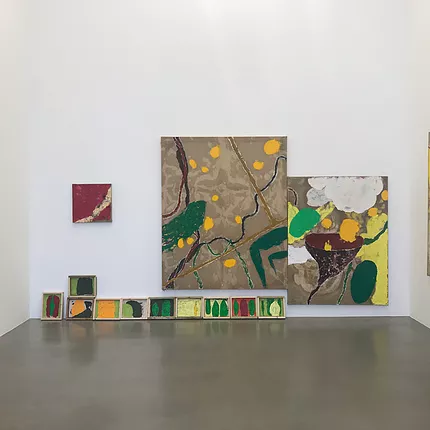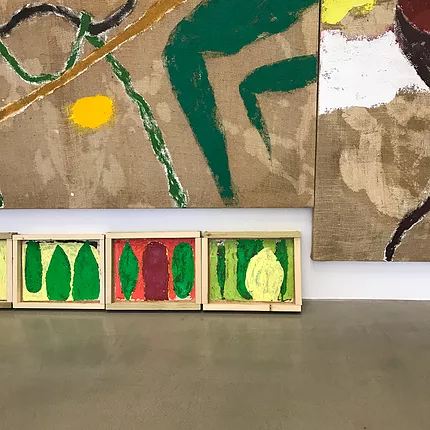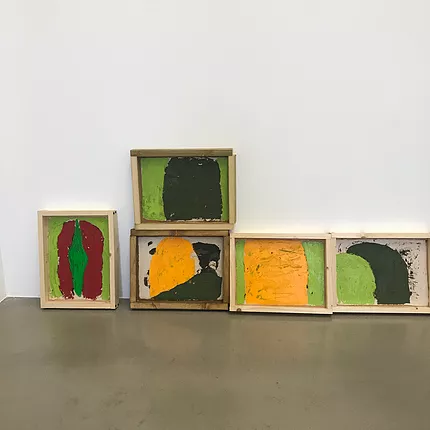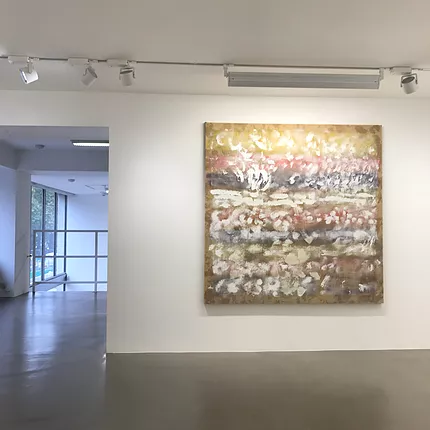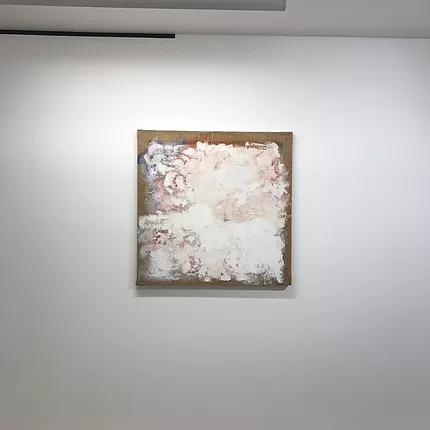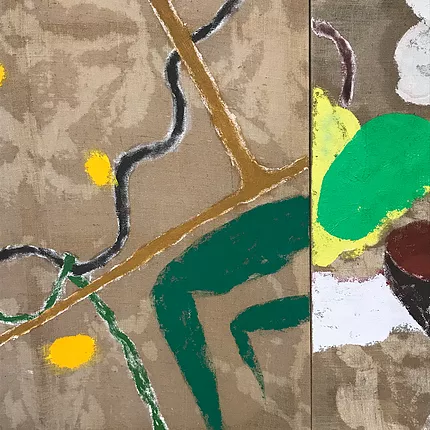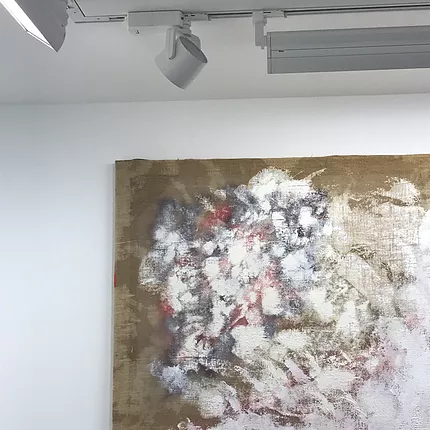Alvaro Barrington, 'GARVEY: SEX LOVE NURTURING FAMALAY' @ Sadie Coles
ZM
Emoji summary: ♾🔗⛓
I don’t normally read other people’s reviews of shows with sincerity. Maybe that’s partly bc of the way we started TWP; we created an oppositional identity, based on a perceived lack. I would also like to still maintain that I don’t rly rate most other critics. But something shifted gear for me, I read Rianna Jade Parker’s review of Alvaro Barrington’s ‘GARVEY: SEX LOVE NURTURING FAMALAY’ at Sadie Coles, and it made me want to see what she was writing about. I would also like to put it on record that I do obviously rate Rianna, not least because in this specific moment, this was a viewing experience I haven’t had in a while: taking someone else’s words with you as you go round the gallery. These little morsels, commas like breadcrumbs, as you savour the space between lines, project meaning - as fantasy or horoscope - for what you’re experiencing in the gallery space.
I have mentally checked out a month early ahead of our December break, I am so ready for a whole month of being afk, OoO, glad we take this time for ourselves every year now. I was glad for the support, the guide rope of Rianna’s words; commercial Mayfair galleries can feel alienating in the same way fancy boutiques do. I have never felt anything other than overwhelmingly conspicuous in them, and still now after 4 years of being an Actual Real Life Art Critic, it amazes me that I can still feel that way in spaces. But beyond that alienation n mental distance: in a way, it was just me, the text & the work. At first glance through the obnoxiously enormous window of Sadie Coles, the work is a collection of paintings. I glanced back down at Rianna’s text, open on my phone, re-read the sentence, ‘On the first floor, oversized and mostly square canvases, made of burlap instead of cotton, are embellished in green, red and black paint – the colours that make up the Pan-African flag, which Garvey designed in 1920.’ I look back up, and it’s tbh the colour of it all that I want to soak in first. These super saturated canvasses, heavy with opaque blocks of colour; the smaller ones are just as heavy as the bigger ones, lined up on the floor, just resting against the wall (some stacked on top of others). I think paintings like this always hit something within me, some part of my body that used to paint but gave it up, but remembers the deep physical satisfaction of it. This mad alchemy of mixing and applying and making images before your eyes, this physical act that has a kind of transformative happiness, of being able to see affect and labour visibly. I feel like these paintings, as they surround me, all hit that part of me first.
The back wall of the ground floor gallery feels like a happy consolidated moment in the midst of it, settled into its composition and balance. One large canvas, with most of the burlap still showing; the image painted on is a stringy kinda wispy moment, some heavy pressed parts, but with most of the image dominated by a slight staining (oil or residue, I don’t know enough about painting u kno). As the canvases gets smaller, the paint takes up more and more space on the canvas, as the burlap background is eclipsed by heavy, pastey gestures. The smaller canvasses too, are either on the back of a canvas - inversed - or boxed in from the front. They set a tone for a different pace of viewing, I have to crouch down to look them in the eye, bend my knee and peer across it as support.
As I am on the floor, I scroll back to the first paragraph of Rianna’s text, it outlines the context of who Marcus Garvey was in relation to London & this body of work. For me, completely honestly, it is a political connection that’s distant from me, my experiences & my identity. That’s ok. The theory this work engages with is theory meant to be felt, enacted, embodied and understood by and through the body. It can be lofty and detached, but I‘ve always felt it should be understood as grounded in the Real. It is something I can only feel in parallels or likeness. When Rianna writes about the manifestos (stacked on the floor in front of the window, across from my most favourite wall), ‘best not to be read as a linear statement but rather a stream of consciousness, sharp utterances and things you would hesitate to repeat in mixed company’, I can only understand what she means in approximations and equivalents. This is enough of an experience and enjoyment for me, I’m glad again, differently, for Rianna’s text as an intermediary between the work and my own interaction with it. It is facilitating an interface between my language and its language, not quite a translator, but maybe a porous membrane that lil nutrients and particles and understandings can filter through.
There’s another room, upstairs. Rianna doesn’t mention the works up here in detail, and as I’m viewing them, they slip past me a bit. They’re in the same family as the ones downstairs, but it’s like they’ve been through the wash. There’s a lil peek of the colours, but they’re washed out, like they’ve been sponged off, and then on top they’re obliterated by this splotchy, but consistently gestural, white opaque mist. Maybe it’s a political point, but I’m too hesitant to assume any symbolic meaning in that. They’re just quieter than downstairs, and as I rest on the bench in the middle (n unscrew the lid of my water bottle), two white buyers with American/international accents walk through to the open plan office next door. They speak loudly, about how they travelled to India and bought some ‘beautiful Khadi cotton shirts’. I am too tired to roll my eyes, I want December now. I sit for a moment, thinking about that article about how those white classical marble sculptures from Greece and Rome were actually painted vivid colours back in the day. I pull it up on my phone, hoping to find another anchor to gel the space between me and the works, but it’s too long to skim, and the visitors are loud. I leave, find a Pret round the corner & wait for the article to load.
‘In Germany, Goethe declared that “savage nations, uneducated people, and children have a great predilection for vivid colors.” He also noted that “people of refinement avoid vivid colors in their dress and the objects that are about them.”’ This persistent lie that the classical statues had always been (or would remain in our collective imaginary) as white is tied up in race, aesthetics, our conception of the West as a thing that exists as a factual construction rather than a social one. Maybe, maybe, it feels tenuous and not as cogent. I switch back to the tab with Rianna’s text on, and re-read a paragraph with a bit more attention and I realise that there was a publication alongside the show. I am ok without it, but I send a request to the press email anyway. My head resting on my hand, steaming coffee makes the bridge of my nose tacky with condensation. I have the manifesto open in front of me and I read the closing lines. ‘REAL EMPATHY NOT THIS PSUEDO CULTURAL CAPITALIST WOKE THAT PEOPLE EXERCISE NOW A DAYS / EMPATHY THAT REQUIRES REAL LISTENING AND IMAGINATION AROUND SOMEONE ELSE’S LIVED EXPERIENCE. EVERYTHING I EXPERIENCE IS REAL’. I remember the closing lines of Rianna’s review, ‘Whilst embracing, he[Barrington] was comforted both by the sound of the heavy tropical rain pelting the rooftop and by the kind of kinship you can literally hold.’ This is all a closed circle and the placement of all these words are the border holding something, some kind of understanding inside them.
I am glad, today and every other day from then, inshallah, for the true power that critics can hold, if they’re good at their job. Like a medium, speaking for those on the other side, it is weirdly-weilded power. I am not alone, the lack I perceived when we started TWP was just a lack at the most visible end. I am standing in the same field as some incredible people, and art is a sticky place to rest, but my experience of Alvaro’s show was shaped by Rianna’s text. This is now half-a-review, bc it is so affected, and I’m so fuckin GLAD! Bc the other half that’s not a review is (imo) more interesting as a starting point than anything I could’ve written otherwise. As Gab looks towards making her texts tighter, more concise and clipped, maybe I am now looking to cross-pollinate. Looking at this exhibition through other texts has been useful, has allowed me to reach an experience I wouldn’t have had otherwise, and it’s been what I needed now more than ever (as I drag myself through a whole month of Friday-4pm-feelings, exhausted and ready for the month off we take every year in december). Maybe the feeling of dissatisfaction I described earlier this year is being ruptured by a gust, as I throw the window open, and look past myself and this insular chiselling that has defined my writing this year. This is a half-review, because the other half hasn’t set yet. It is still congealing in my mouth and I’m not ready to spit it out and see the shape of it. I am looking forward to December, as a paragraph break. I am looking forward to January, as a gear change. I am glad for other critics, as the kind of empathy Alvaro describes.
Alvaro Barrington's show 'GARVEY: SEX LOVE NURTURING FAMALAY' @ Sadie Coles is on until 9th November. There was also a show on @ Emalin, opposite Shoreditch High St, of works by Teresa Farrell & Alvaro Barrington, called 'TALL BOYS & A DOUBLE SHOT ESPRESSO'. It's closed now, but there are some other events n it's worth a lil retrospective peep.
